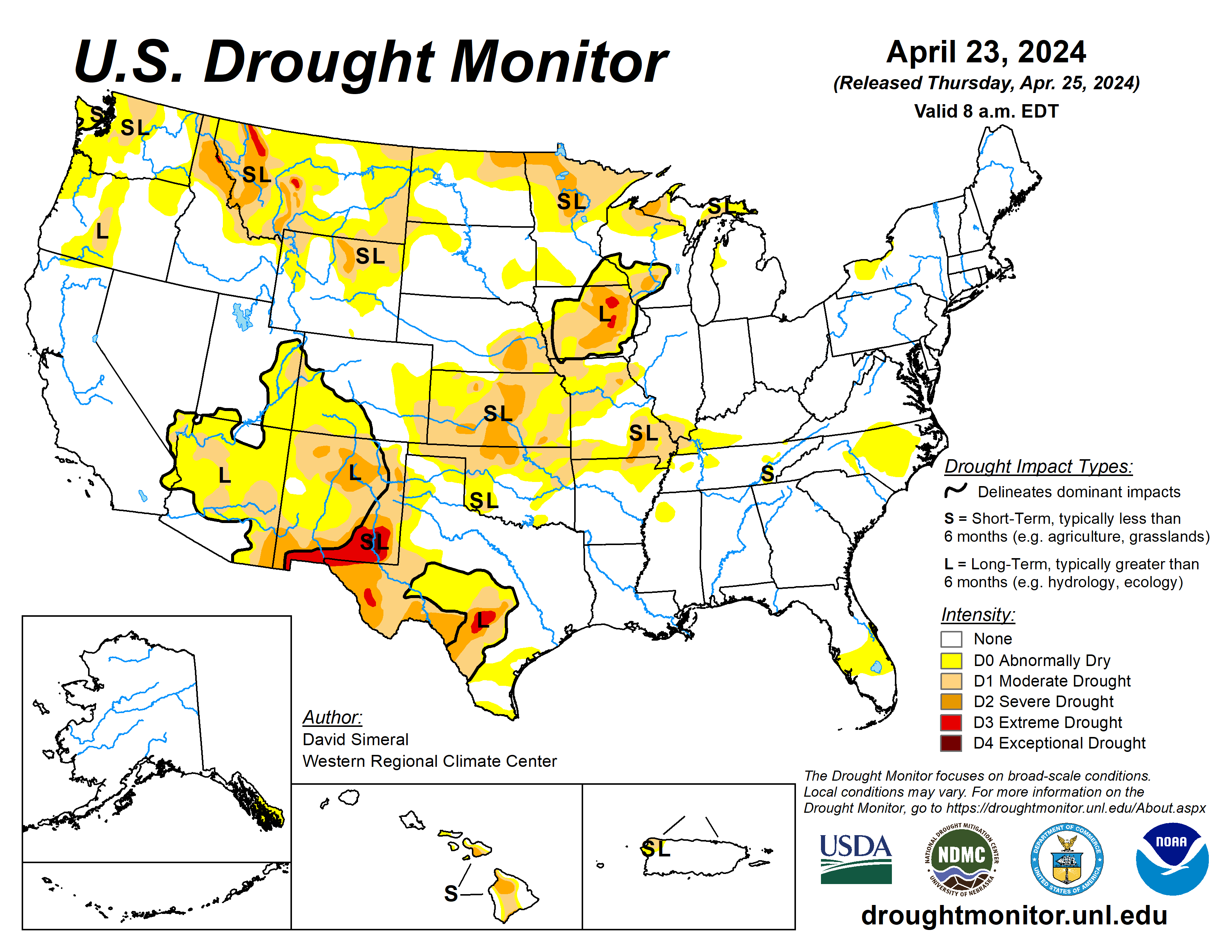NASS updates wheat ratings in latest crop progress report

High Plains region states are experiencing varying levels of drought conditions. Eastern Nebraska, the majority of Kansas, parts of Oklahoma and southwest Texas are seeing conditions ranging from abnormally dry to pockets of exceptional drought, according to the April 23 U.S. Drought Monitor Map.
North Dakota—For the week ending April 21, the U.S. Department of Agriculture, National Agricultural Statistics Service reported topsoil moisture supplies rated 10% very short, 27% short, 60% adequate, and 3% surplus. Subsoil moisture supplies rated 11% very short, 31% short, 55% adequate, and 3% surplus.
Spring wheat planted was 7%, ahead of 1% last year, and near 5% for the five-year average. Durum wheat planted was 2%, near 1% last year, and equal to average. Winter wheat condition rated 1% very poor, 4% poor, 34% fair, 60% good, and 1% excellent. Winter wheat jointed was 3%, near 5% last year and 7% average.
South Dakota—For the week ending April 21, USDA, NASS reported topsoil moisture supplies rated 1% very short, 18% short, 76% adequate, and 5% surplus. Subsoil moisture supplies rated 3% very short, 25% short, 69% adequate, and 3% surplus.
Winter wheat condition rated 1% very poor, 3% poor, 33% fair, 61% good, and 2% excellent. Spring wheat planted was 40%, well ahead of 3% last year, and ahead of 21% average. Emerged was 6%, near 5% average.
Nebraska—For the week ending April 21, USDA, NASS reported topsoil moisture supplies rated 12% very short, 33% short, 51% adequate, and 4% surplus. Subsoil moisture supplies rated 11% very short, 39% short, 46% adequate, and 4% surplus.
Winter wheat condition rated 2% very poor, 3% poor, 27% fair, 52% good, and 16% excellent.
Kansas—For the week ending April 21, USDA, NASS reported topsoil moisture supplies rated 27% very short, 38% short, 34% adequate, and 1% surplus. Subsoil moisture supplies rated 24% very short, 40% short, 35% adequate, and 1% surplus.
Winter wheat condition rated 8% very poor, 18% poor, 38% fair, 33% good, and 3% excellent. Winter wheat jointed was 72%, well ahead of 41% last year and 48% for the five-year average. Headed was 4%, near 2% last year and 1% average.
Oklahoma—For the week ending April 21, USDA, NASS reported topsoil and subsoil moisture conditions were rated adequate to short.
Winter wheat jointing reached 83%, up 4 points from the previous year and up 2 points from normal. Winter wheat headed reached 30%, up 2 points from the previous year and up 10 points from normal. Rye jointing reached 80%, up 12 points from the previous year and up 4 points from normal. Rye headed reached 5%, down 32 points from the previous year.
Texas—For the week ending April 21, USDA, NASS reported crop progress continued to improve despite some dry and windy conditions. Rainfall ranged from trace amounts to 6 inches.
Winter wheat and oats progress remained steady. In the Blacklands, the Cross Timbers, and south east Texas, winter wheat continued to head out. Leaf rust and hot spots were reported in the northern portion of the state. Some producers throughout the state were cutting wheat for hay, while more rain was needed in the Edwards Plateau and the Coastal Bend. Winter wheat headed reached 50%, up 2 points from the previous year.
To see more of the NASS crop progress reports visit https://www.nass.usda.gov/.
Kylene Scott can be reached at 620-227-1804 or [email protected].



